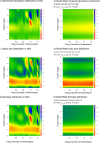Stability lies in flowers: Plant diversification mediating shifts in arthropod food webs
- PMID: 29451903
- PMCID: PMC5815608
- DOI: 10.1371/journal.pone.0193045
Stability lies in flowers: Plant diversification mediating shifts in arthropod food webs
Abstract
Arthropod community composition in agricultural landscapes is dependent on habitat characteristics, such as plant composition, landscape homogeneity and the presence of key resources, which are usually absent in monocultures. Manipulating agroecosystems through the insertion of in-field floral resources is a useful technique to reduce the deleterious effects of habitat simplification. Food web analysis can clarify how the community reacts to the presence of floral resources which favour ecosystem services such as biological control of pest species. Here, we reported quantitative and qualitative alterations in arthropod food web complexity due to the presence of floral resources from the Mexican marigold (Tagetes erecta L.) in a field scale lettuce community network. The presence of marigold flowers in the field successfully increased richness, body size, and the numerical and biomass abundance of natural enemies in the lettuce arthropod community, which affected the number of links, vulnerability, generality, omnivory rate and food chain length in the community, which are key factors for the stability of relationships between species. Our results reinforce the notion that diversification through insertion of floral resources may assist in preventing pest outbreaks in agroecosystems. This community approach to arthropod interactions in agricultural landscapes can be used in the future to predict the effect of different management practices in the food web to contribute with a more sustainable management of arthropod pest species.
Conflict of interest statement
Figures





Similar articles
-
Comparison of pollinators and natural enemies: a meta-analysis of landscape and local effects on abundance and richness in crops.Biol Rev Camb Philos Soc. 2013 Nov;88(4):1002-21. doi: 10.1111/brv.12040. Epub 2013 Apr 12. Biol Rev Camb Philos Soc. 2013. PMID: 23578337 Review.
-
Floral diversity increases beneficial arthropod richness and decreases variability in arthropod community composition.Ecol Appl. 2013 Jan;23(1):86-95. doi: 10.1890/11-2029.1. Ecol Appl. 2013. PMID: 23495638
-
A global synthesis of the effects of diversified farming systems on arthropod diversity within fields and across agricultural landscapes.Glob Chang Biol. 2017 Nov;23(11):4946-4957. doi: 10.1111/gcb.13714. Epub 2017 May 10. Glob Chang Biol. 2017. PMID: 28488295
-
Connecting scales: achieving in-field pest control from areawide and landscape ecology studies.Insect Sci. 2015 Feb;22(1):35-51. doi: 10.1111/1744-7917.12161. Epub 2014 Nov 14. Insect Sci. 2015. PMID: 25099692 Review.
-
Natural enemy-herbivore networks along local management and landscape gradients in urban agroecosystems.Ecol Appl. 2020 Dec;30(8):e02201. doi: 10.1002/eap.2201. Epub 2020 Jul 28. Ecol Appl. 2020. PMID: 32578260
Cited by
-
A parasitoid's dilemma between food and host resources: the role of volatiles from nectar-providing marigolds and host-infested plants attracting Aphidius platensis.Naturwissenschaften. 2021 Dec 16;109(1):9. doi: 10.1007/s00114-021-01780-8. Naturwissenschaften. 2021. PMID: 34913094
-
Manipulation of Agricultural Habitats to Improve Conservation Biological Control in South America.Neotrop Entomol. 2019 Dec;48(6):875-898. doi: 10.1007/s13744-019-00725-1. Epub 2019 Nov 11. Neotrop Entomol. 2019. PMID: 31713220
-
Composition of tropical agricultural landscape alters the structure of host-parasitoid food webs.Heliyon. 2021 Jul 19;7(7):e07625. doi: 10.1016/j.heliyon.2021.e07625. eCollection 2021 Jul. Heliyon. 2021. PMID: 34377859 Free PMC article.
-
Reducing Pesticides and Increasing Crop Diversification Offer Ecological and Economic Benefits for Farmers-A Case Study in Cambodian Rice Fields.Insects. 2021 Mar 21;12(3):267. doi: 10.3390/insects12030267. Insects. 2021. PMID: 33801159 Free PMC article.
-
Long-term changes as oil palm plantation age simplify the structure of host-parasitoid food webs.PLoS One. 2023 Oct 10;18(10):e0292607. doi: 10.1371/journal.pone.0292607. eCollection 2023. PLoS One. 2023. PMID: 37816027 Free PMC article.
References
-
- Clough Y, Kruess A, Tscharntke T. Local and landscape factors in differently managed arable fields affect the insect herbivore community of a non-crop plant species. Journal of Applied Ecology. 2007;44(1):22–8. 10.1111/j.1365-2664.2006.01239.x - DOI
-
- Rusch A, Valantin-Morison M, Sarthou JP, Roger-Estrade J. Effect of crop management and landscape context on insect pest populations and crop damage. Agriculture, Ecosystems & Environment. 2013;166(0):118–25. 10.1016/j.agee.2011.05.004. - DOI
-
- Chapin FS III, Zavaleta ES, Eviner VT, Naylor RL, Vitousek PM, Reynolds HL, et al. Consequences of changing biodiversity. Nature. 2000;405(6783):234–42. - PubMed
-
- Schmidt MH, Thies C, Nentwig W, Tscharntke T. Contrasting responses of arable spiders to the landscape matrix at different spatial scales. Journal of Biogeography. 2008;35(1):157–66. 10.1111/j.1365-2699.2007.01774.x - DOI
-
- Perović DJ, Gurr GM, Raman A, Nicol HI. Effect of landscape composition and arrangement on biological control agents in a simplified agricultural system: A cost–distance approach. Biological Control. 2010;52(3):263–70. 10.1016/j.biocontrol.2009.09.014. - DOI
Publication types
MeSH terms
LinkOut - more resources
Full Text Sources
Other Literature Sources

